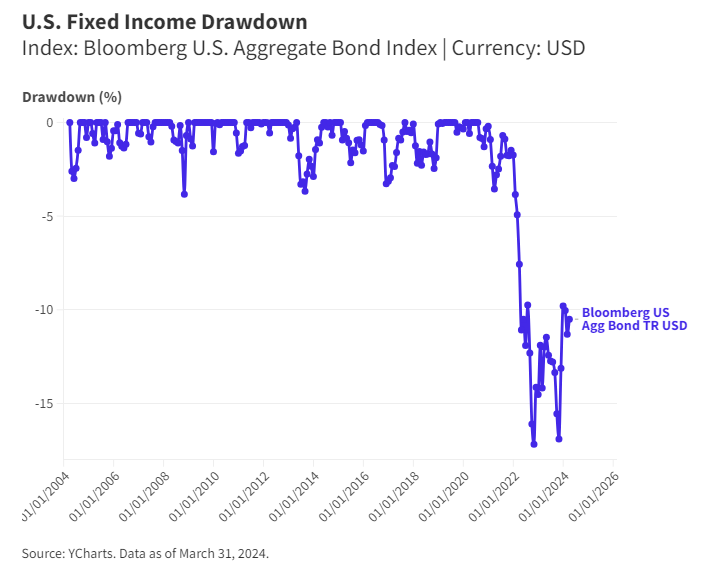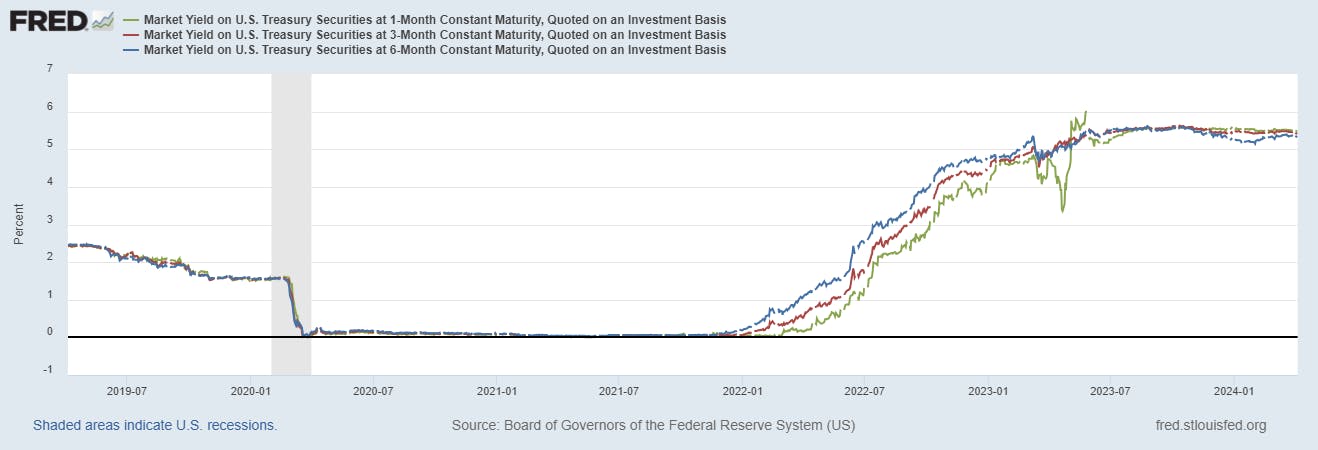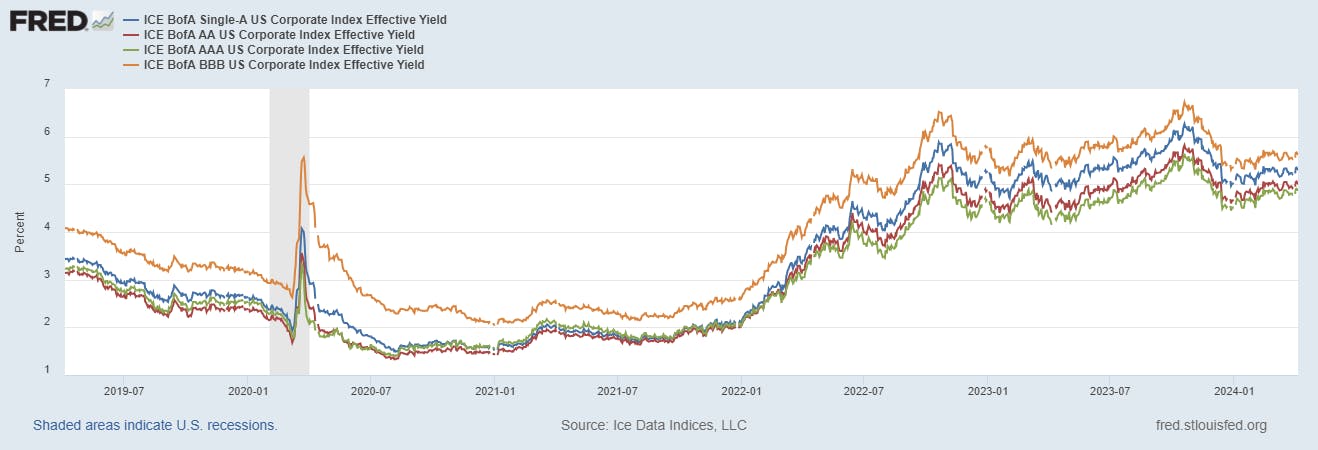While U.S. equity markets have taken center stage in the minds of investors due to their strong performance, U.S. fixed-income markets have been in a historic drawdown. Against this contrasting background, what is the compelling rationale for holding U.S. fixed income at this juncture? This article will highlight the current backdrop for U.S. fixed income and why investors can still benefit from having exposure to this particular asset class.
The current backdrop
U.S. fixed income has been on its longest drawdown, 44 months to be specific, with no immediate sign of a recovery. The precipitous climb in interest rates over the past three years has set the stage for the environment we are currently in, and while the consensus coming into the new year was that the U.S. Federal Reserve will cut rates in 2024, incoming macroeconomic data is providing no basis as to why rates should be reduced in the immediate time frame.
Recent incoming U.S. data showed nonfarm payrolls rose 303,000 in March and unemployment fell, pointing to a strong labor market that’s powering the U.S. economy. Whereas inflation rose 0.4 percent in March, with the All Items Index increasing to 3.5% over the last 12 months.

Looking beyond the data, the commentary of various Federal Reserve Presidents has indicated what is likely to occur – rates will remain higher for longer. As reported by Bloomberg News, Federal Reserve Bank of Dallas President Lorie Logan said it’s too soon to consider cutting interest rates, citing recent high inflation readings and signs that borrowing costs may not be holding back the economy as much as previously thought.
Furthermore, Federal Reserve Chair, Jerome Powell, was quoted saying “The fact that the U.S. economy is growing at such a solid pace, the fact that the labor market is still very, very strong, gives us the chance to just be a little more confident about inflation coming down before we take the important step of cutting rates”.
The Case for U.S. Bonds
While many investors and savers have become enamored with the yields being quoted on U.S. Treasury instruments, in truth, there is no certainty they will remain at this or a similar level for the next 5 to 10 years. Conversely, if investors were to buy bonds now, they would be able to lock in similar levels of yield generation for a much longer period.


While locking in a high yield is one rationale, the other consideration is capital appreciation. Given the inverse relationship between bond yields and price, buying bonds now could be highly profitable. The fact that rates, and by extension yields, were lower in previous years meant that there was little income or embedded yield against which to offset negative price moves. In recent years, price return has been negative, this is primarily due to rising rates.
With rates peaking in the U.S., there is no expectation for this to be a headwind for fixed-income investors, and going forward there will be a far larger yield buffer to cushion any unforeseen, negative price moves. While the timing as to when rates will go down is unknown, there is a clear expectation for yields to fall, and for price return to be a positive driver going forward.
Getting paid for patience and rewarded in the long run
The true case for U.S. fixed income at this immediate juncture is being rewarded for one’s patience. With the yield on high-quality corporate debt portfolios being around five percent, the income represented by these yields can provide the foundation for meaningful future returns and a ballast against current price weakness. With bond yields being at or near their highest level in almost a decade, long-term investors may expect improved future returns on their fixed-income investments.
Though investors need to exercise patience at this juncture of the economic cycle, high-quality fixed income will continue to offer a compelling yield should rates remain as they currently are or higher; however, if rates decline, investors will benefit from this change.
Investing in U.S. Fixed Income through ETFs
For Canadian investors who are interested in U.S. fixed income, the below solutions are worthy of consideration:
iShares 1-5 Year U.S. IG Corporate Bond Index ETF (CAD-Hedged) (Ticker: XIGS)
XIGS is a passively managed strategy replicating the ICE (NYSE:ICE) BofA 1-5 Year U.S. Corporate Index (CAD-Hedged), composed of U.S. dollar-denominated, investment-grade corporate bonds with remaining maturities between one and five years. Through this solution, investors gain access to 2000+ high-quality corporate bonds in a single fund.
BMO (TSX:BMO) Mid-Term U.S. IG Corporate Bond Index ETF (Tickers: ZIC or ZIC.U)
ZIC (or ZIC.U) is a passively managed strategy that will replicate the Bloomberg Barclays (LON:BARC) U.S. Investment Grade 5-10 Year Corporate Bond Index, which consists of United States dollar-denominated, investment grade, fixed-rate, taxable corporate bonds between 5-10 years until maturity. Through this solution, investors gain access to a diversified portfolio of U.S. corporate bonds and will receive consistent income.
TD (TSX:TD) Active U.S. High Yield Bond ETF (Ticker: TUHY)
TUHY is an actively managed solution that employs a “buy-and-hold” strategy in selecting high-yield corporate bonds that are rated BB+ to B- by nationally rated credit agencies at the time of purchase and may hold other income-generating securities from issuers located primarily in the United States. The portfolio adviser believes a bottom-up strategy emphasizing analysis of credit fundamentals of the largest issuers of high-yield bonds in a global macroeconomic environment will add value and enhance long-term performance.
The selection and portfolio construction process are based on a methodical risk/return analysis with the objective of capturing long-term returns offered primarily by the pre-selected largest components of the U.S. high-yield bond market.
This content was originally published by our partners at the Canadian ETF Marketplace.
